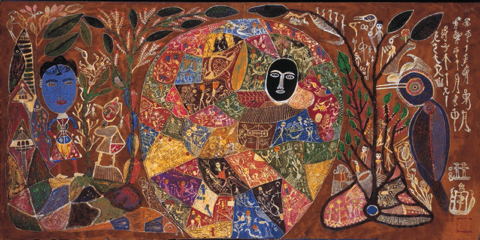Died 23 February 1987 | ||
 | ||
Hung Tung (Hong Dong) (Simplified Chinese:洪通; Traditional Chinese: 洪通; Pinyin: Hóng Tong; born 1920) was a Taiwanese painter whose work, notable for its folk style, vivid colour and unique personal language, had a significant influence on the direction of Taiwanese Modern art in the 1970s.
Contents
- Tracy ngaihching ni lopi hung tung ding
- Biography
- Work
- Major exhibitions
- The Nativist movement
- Legacy
- References
Tracy ngaihching ni lopi hung tung ding
Biography
Hung Tung was born in 1920, in a fishermen's village near the Nankunshen Temple in Tainan's Beimen Township. Hung was orphaned as a young child. Raised by impoverished relatives, he was unable to attend school. From an early age, Hung supported himself and his family by doing odd jobs. He also worked as a spirit medium in a Taoist temple. Having no formal education, Hung was illiterate for the duration of his life; this did not stop him exploring other modes of expression. In 1970, at the age of 50, Hung Tung felt a desire to paint; this turning point marked the beginning of his career as an artist. In 1972, the self-taught artist put works on display outside the Nankunshen Temple. Upon viewing his mysterious creations, a journalist wrote about Hung’s works in The Artist Magazine. From this point forth, he began receiving extensive coverage in art magazines, and became the subject of heated debates about what constituted ‘Taiwanese’ art. In 1976, Hung Tung’s first major solo exhibition organised by The Artist magazine at the American Cultural Centre in Taipei meant he became a household name overnight in Taiwan. During this period in the 70’s, Taiwan was still conservative, Hung Tung’s art was polarising since the public since found it difficult to conceive how an illiterate person could start painting without any formal training. The public and his fellow villagers were divided into those who appreciated Hung’s art for its genius and those who thought he was a fool. Hung’s popularity throughout Taiwan meant that he received constant requests for paintings. Hung refused to sell his paintings so these requests soon became an encumbrance. In later life Hung began to isolate himself. In 1986 Hung’s wife died. A year later in 1987, Hung died in his sleep, alone in his workshop. During his artistic career, Hung produced over 300 finished artworks. The Taiwanese community acknowledges him as being an accomplished painter since his works show unique personal style and capture the local essence of Taiwan. Hung Tung’s contribution paved the way for the Nativist movement in Taiwan.
Work
Hung Tung’s paintings suffuse strange beings, coloured faces, flowers, birds, trees, boats and air planes with hieroglyphic symbols. These elements give a very childlike spirit and imagination to Hung Tung’s works. Also taking inspiration from Taiwanese opera, puppet shows, temple fairs, temple sculptures and ritualized performance troupes; the imagery he adopts infuses his works with elements from Taiwanese folklore, Daoism and mysticism. His paintings adopt a lively palette and the compositional elements interact on the same plane, since Hung Tung adopts a one plane perspective. He also used unconventional means of expression by painting with both his left and rights hands. Ultimately, the mix of Taiwanese folk tradition, with a bright choice of palette and unique sense of perspective adds local flavour and Taiwanese essence to Hung Tung’s works.
Major exhibitions
The Nativist movement
In the Nativist movement in Taiwan, artists reawakened to the social reality of their local environment, instead of blindly following Western trends, a number of artists like Hung Tung and Ju Ming directed their attention to folk art to derive inspiration from native surroundings. Hung Tung’s works, which depict people’s daily lives, are suffused with the brilliant and vibrant contrasting colours of folk art. By incorporating dynamic pictographic symbols, he develops a unique personal language, which, full of magic and illusions that convey the fantastic power of popular belief, shows a lack of concern for western realism. Hung Tung works show how the greatest significance of the Nativist movement was not the just the emergence of home-spun artist, but the widespread concern for using abstract means to explore local themes rooted in the immediate environment to re-evaluate modernist thought. Ultimately, Hung Tung’s contribution extended not only to the birth of the Nativist art movement but was also important in redefining conceptions of the ‘local’ Taiwanese identity. In the 1980s, Taiwanese artists developed strong consciousness about their own subjectivity in response to global and national historical forces, transforming models of Western art and theories into a New Nativist art; Taiwanese art became even more multifaceted.
Legacy
During his lifetime, there were several major exhibitions of his work in Taiwan. After his death, at least two books in Chinese have been published about him. Yet other than a feature story in Raw Vision Magazine (issue #48) and a few other minor mentions in books and periodicals, Tung’s work is almost unknown in the West. Cheng Chia-yin, the director of the Taipei-based drama troupe Puppet and Its Double, is inspired by Hung Tung’s psychic powers and life story. His vision for unveiling Tung’s life in the project "Who's Hung Tung?" (洪通計劃), in the 2011 Taipei Arts Festival has brought about a three part project. The drama, documentary and exhibition show the life of Hung Tung, as he went from being an illiterate labourer to becoming a highly accomplished painter. The goal of the project is to help youngsters step into the world of Hung's art. She also hopes that young performers and audiences can immerse themselves in the artist's imagination and gain a better understanding of his life.
